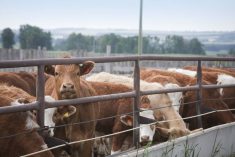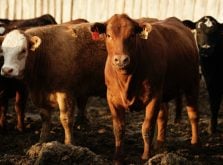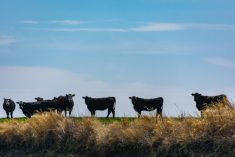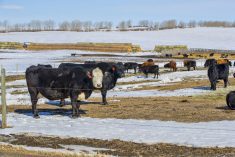During the latter half of June, Alberta packers were buying fed cattle in the range of $170-$173 f.o.b. the feedlot in southern Alberta. The market was up $2 to $3 from 30 days earlier. Prices were marking fresh 52-week highs as feedlots in Western Canada contend with a backlog of market-ready supplies.
The fed cattle market in Nebraska continues to trade at a $10-$12 premium to Alberta while Ontario packer bids are $15 to $18 above Alberta values. Trade flows are in the process of narrowing this Alberta discount but it looks like fed supplies in Western Canada will only tighten later in the fall period.
South of the border, a wall of cattle will on the market in July and August which will slow fed cattle exports to the U.S. While beef production is coming in larger than anticipated, demand is holding up better than expected despite higher inflation.

U.S. grocery store sales during May were up 7.8 per cent from May of 2021; the latest data has Canadian grocery store sales for April coming in very similar to a year ago. U.S. and Canadian retail beef prices are up 12 to 14 per cent from a year ago. However, wholesale prices are down 18 per cent from June of 2021.
Read Also

Harvest wraps up and fall work begins
At the Eppich famly ranch in western Saskatchewan, the fall harvest was successful with few breakdowns, cows and calves have been sorted and a new tractor has arrived
Looking forward, beef production will drop sharply in the fourth quarter of 2022 and first quarter of 2023. This should cause Canadian fed cattle prices to trade up to historical highs in March/April 2023.
Pastures are poor
U.S. pasture conditions as of June 12 were rated 42 per cent very poor to poor. This is the second year in a row that major cattle-producing states have experienced severe drought. This influences the cattle market in two major areas.
First, feeder cattle are placed into feedlots sooner than normal. Despite the year-over-year decrease in the U.S. calf crop, feedlot placements from Jan. 1 through April 30 2022 were up 134,000 head over the same timeframe of 2021. Secondly, the cow culling rates are higher than year-ago levels. The U.S. beef cow slaughter during the first four months of 2022 was at 1.302 million head, up 172,000 head from last year. The U.S. beef cow slaughter for the 2022 calendar year is expected to reach 3.850 million head, similar to the historically high beef cow slaughter of 2011.
The year-over-year increase in U.S. feedlot placements during the first four months of 2022 will result in a year-over-year increase in beef production during the third quarter of 2022. Once the market chews through these larger supplies, beef production will drop sharply during the fourth quarter. U.S fourth-quarter beef production is projected to finish just under 6.7 billion pounds, down 400 million pounds from the fourth quarter of 2021.
Beef production continues to decline into the first quarter. During 2023, the beef cow slaughter will be down nearly one million head from 2022. The U.S. will also be contending with another year-over-year decrease in the calf crop. U.S first-quarter beef production is projected to drop to 6.5 billion pounds, down 500 million pounds from the first quarter of 2022.
Heifers will be retained
Given the lower beef production, the function of the feeder market is to encourage expansion. The U.S. cow-calf producer will hold back on heifers this fall and winter in an effort to rebuild the herd. I’m looking for a sharp year-over-year decrease in the U.S. cow slaughter. Of course, this depends on the forage, hay and feed grain situation.
As of late June, the weather forecast for much of the Corn Belt called for above-normal temperatures and below-normal precipitation. The weather is the major caveat to the feeder price outlook as the corn market could trade back up to historical highs.
In Western Canada, recent rains have enhanced the probability for average-yielding wheat and barley crops. If we take into account the lower U.S. calf crop along with expected heifer retention during the fall, U.S. feeder cattle supplies will be down nearly one million head from year-ago levels from September 2022 through March 2023. The potential for record-high corn prices this fall could temper the upside in the feeder market. Nevertheless, stronger fed cattle prices will cause the feeder market to trend higher.
Interest rates are percolating higher but are still low by historical standards. This is the year for Canadian cow-calf producers to expand. Secondly, cow-calf producers want to hold onto their calves as long as possible in the fall period to receive the highest price. Next year, the U.S. producer will move into a major expansion and you want to be at least one year ahead of your neighbour.
















